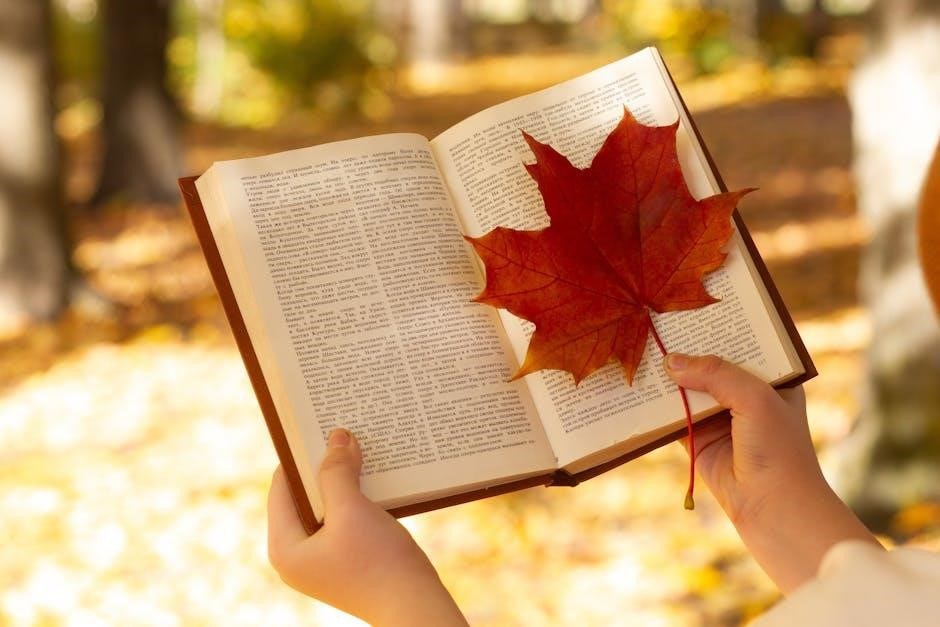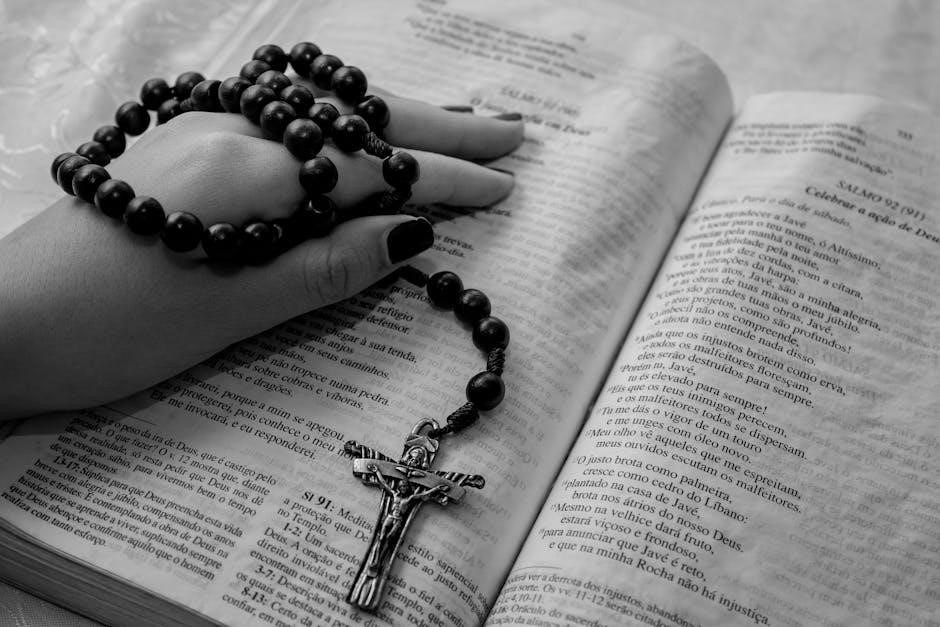The Book of Lilith PDF explores the myth of Lilith, the first woman created equal to Adam, delving into her symbolism as the repressed feminine archetype․ Barbara Black Koltuv’s work examines Lilith’s role in biblical and mystical traditions, offering insights into her connection to the Great Goddess and modern feminist movements․ This text, available in PDF format, provides a deeper understanding of Lilith’s significance in history, psychology, and spirituality, making it a valuable resource for scholars and enthusiasts alike;
Overview of the Book and Its Significance
The Book of Lilith PDF delves into the mythological and psychological dimensions of Lilith, offering a profound exploration of her role as a symbol of the repressed feminine archetype․ Written by Barbara Black Koltuv, the book examines Lilith’s origins in biblical and mystical traditions, highlighting her significance as a figure of empowerment and rebellion․ It draws on Jungian psychology to explore the motherless feminine Self and its relevance in modern times․ The text also discusses Lilith’s connection to the Great Goddess and her role in left-hand path magic, making it a comprehensive resource for understanding her enduring legacy․ The book’s insights into Lilith’s mythos provide a deeper understanding of feminine spirituality and its cultural impact․
Barbara Black Koltuv and Her Exploration of Lilith

Barbara Black Koltuv, a renowned Jungian analyst, delves into the myth of Lilith in her book, offering a deep psychological and symbolic exploration․ Her work examines Lilith as a representation of the repressed feminine archetype, drawing from biblical, mystical, and Kabbalistic texts․ Koltuv’s analysis highlights Lilith’s role as a figure of empowerment and rebellion, challenging traditional patriarchal narratives․ She explores the motherless feminine Self and its connection to the Great Goddess, providing insights into Lilith’s enduring relevance in modern spirituality․ Koltuv’s approach bridges mythology and psychology, making her book a vital resource for understanding Lilith’s complex legacy and her significance in contemporary feminist and spiritual movements․ Her work continues to inspire those seeking to reclaim the forgotten aspects of the feminine divine․
Historical and Mythological Background of Lilith

Lilith, often depicted as Adam’s first wife, is a figure rooted in ancient mythology, symbolizing rebellion and independence․ Her story spans biblical, Kabbalistic, and Mesopotamian traditions, evolving from a divine being to a controversial icon, reflecting societal attitudes toward femininity and power․
Lilith as the First Woman in Biblical Mythology

In biblical mythology, Lilith is often depicted as the first woman created by God, equal to Adam, from the earth․ She embodies independence and rebellion, refusing to submit to Adam’s authority․ This narrative contrasts sharply with the story of Eve, who was created from Adam’s rib․ Lilith’s defiance led to her banishment from Eden, symbolizing the suppression of feminine power and autonomy․ Her story reflects themes of gender dynamics and the struggle for equality, resonating deeply in feminist interpretations․ The biblical account of Lilith highlights her role as a figure of strength and resistance, challenging traditional patriarchal narratives and offering a powerful symbol of female liberation and self-determination․

The Zohar and the Kabbalistic Perspective on Lilith
The Zohar, a central text of Jewish mysticism, offers a profound exploration of Lilith, depicting her as a figure of immense power and complexity․ According to Kabbalistic teachings, Lilith was created equal to Adam, sharing the same divine substance, and thus refused to submit to him․ The Zohar describes her as the “first wife” of Adam, who fled Eden after asserting her independence․ She is often associated with the divine feminine and the darker aspects of the unconscious․ The Zohar also links Lilith to the “woman of harlotry” in the Book of Proverbs, symbolizing temptation and the shadow self․ Her story in the Zohar serves as a cautionary tale about the dangers of feminine power unchecked and the consequences of rebellion against divine order․
The Alphabet of Ben Sira and Lilith’s Story
The Alphabet of Ben Sira, a medieval Jewish text, provides a detailed narrative about Lilith, emphasizing her role as Adam’s first wife․ According to this account, Lilith was created simultaneously with Adam from the same earth, making her his equal․ However, their relationship was marked by conflict due to Lilith’s refusal to submit to Adam’s authority․ This text portrays Lilith as a symbol of independence and feminine power, who ultimately chooses to leave Eden rather than be subjugated․ The Alphabet of Ben Sira also describes Lilith’s subsequent role as a demon and her association with childbirth and infertility․ This narrative has been interpreted as a reflection of patriarchal fears of female autonomy and the suppression of the feminine divine․ It remains a crucial source for understanding Lilith’s enduring legend․

The Book of Lilith: Key Themes and Concepts
The Book of Lilith PDF delves into themes of the repressed feminine archetype, exploring Lilith as a symbol of independence and divine feminine power․ It examines her role in Jungian psychology as a representation of the unconscious and her connection to Mother Earth, highlighting her ecological significance․ The text also discusses Lilith’s journey from a biblical figure to a modern spiritual icon, emphasizing her relevance in contemporary feminist and spiritual movements․ Through these concepts, the book offers a profound exploration of femininity, autonomy, and the divine․
Lilith as a Symbol of the Repressed Feminine Archetype

Lilith, as depicted in The Book of Lilith PDF, embodies the repressed feminine archetype, symbolizing independence and divine power․ Created equal to Adam, her refusal to submit to patriarchal norms highlights her defiance and autonomy․ This mythological figure represents the overlooked aspects of the Great Goddess, reflecting the motherless feminine Self․ Barbara Black Koltuv’s work explores Lilith’s role in Jungian psychology, where she signifies the unconscious and the neglected feminine energies․ Her story challenges traditional narratives, offering a powerful symbol of liberation and self-discovery․ By examining Lilith’s journey, the book provides insights into the suppression of feminine power and its relevance in contemporary feminist and spiritual movements, inviting readers to reclaim and understand this vital archetype․
The Role of Lilith in Jungian Psychology
Lilith, as explored in The Book of Lilith PDF, holds significant relevance in Jungian psychology, representing the repressed aspects of the feminine archetype․ She symbolizes the unconscious, embodying qualities of independence, power, and the shadow․ Barbara Black Koltuv’s work delves into Lilith’s connection to the collective unconscious, where she serves as a symbol of the anima, challenging patriarchal structures․ Her defiance and autonomy reflect the unacknowledged parts of the feminine psyche, offering a path to integration and wholeness․ In this context, Lilith’s journey invites individuals to confront their own shadow and embrace the repressed feminine, fostering psychological balance and self-awareness․ Her role in Jungian thought underscores her importance as a transformative figure in personal and collective growth․
Lilith’s Connection to the Great Goddess and Mother Earth
Lilith, as explored in The Book of Lilith PDF, embodies the untamed and primal aspects of the Great Goddess, symbolizing the earth’s vitality and fertility․ Her connection to Mother Earth stems from her origins as Adamah, the Hebrew term for the feminine earth․ Lilith’s defiance and independence reflect the natural world’s cycles of life, death, and rebirth․ In this context, she represents the instinctual and nurturing forces of the earth, while also challenging patriarchal dominance․ Her story, intertwined with the land and its rhythms, highlights the sacred feminine’s enduring presence in nature and human consciousness․ This connection underscores Lilith’s role as a symbol of ecological balance and the divine feminine’s interplay with the physical world․

Lilith in Modern Literature and Culture
Lilith continues to captivate modern audiences, appearing in literature, art, and media as a symbol of female empowerment and rebellion․ Her story, reinterpreted in works like George MacDonald’s Lilith, resonates with contemporary feminist and spiritual movements, exploring themes of independence and divine femininity․ The Book of Lilith PDF highlights her enduring allure, bridging ancient myths with modern cultural relevance, inspiring new generations to embrace her legacy as a powerful, timeless icon․

The Book of Lilith by George MacDonald
George MacDonald’s Lilith is a fascinating exploration of the mythological figure, blending fantasy and philosophical inquiry․ First published in 1895, the novel reimagines Lilith as a complex character, delving into themes of redemption, morality, and the human condition․ MacDonald’s portrayal diverges from traditional myths, presenting Lilith as a multifaceted being with a deep inner struggle․ The book is part of the public domain and is available as a free eBook through Project Gutenberg, ensuring its accessibility to modern readers․ MacDonald’s unique interpretation of Lilith has captivated audiences, offering a fresh perspective on her legacy in literature and culture․ His work remains a significant contribution to the enduring fascination with Lilith’s story and symbolism․
Lilith in Contemporary Feminist and Spiritual Movements
Lilith has become a powerful symbol in contemporary feminist and spiritual movements, embodying female empowerment and autonomy․ She represents the untamed, independent feminine archetype, challenging patriarchal narratives․ In modern spirituality, Lilith is often revered as a goddess figure, associated with the divine feminine and Mother Earth․ Her story resonates with those seeking to reclaim suppressed aspects of femininity and sexuality․ Within feminist discourse, Lilith symbolizes resistance against oppression, reflecting the struggle for gender equality․ Spiritual practices often incorporate Lilith as a figure of liberation, offering rituals and meditations to connect with her transformative energy․ Her enduring presence in these movements highlights her relevance as a symbol of both empowerment and the reclamation of the divine feminine in modern times․
Modern Interpretations of Lilith in Art and Media
Lilith’s enigmatic figure has inspired modern artists, writers, and creators, reimagining her as a symbol of empowerment and defiance․ In contemporary art, she is often depicted as a powerful, independent woman, embodying feminist ideals․ Music and literature frequently reference Lilith, exploring her complexities and rebellious spirit․ Films and TV shows portray her as a mysterious, sometimes dark, yet captivating character․ Her image also appears in tattoos and visual art, symbolizing personal liberation and strength․ Modern interpretations often blend traditional myths with fresh perspectives, highlighting Lilith’s relevance in today’s cultural landscape․ Through these creative expressions, Lilith continues to evolve, reflecting the changing perceptions of femininity, power, and individuality in society․
The Magick and Spirituality of Lilith
Lilith embodies a powerful symbol in modern spirituality, representing empowerment and shadow work․ Her magick often involves rituals for liberation and self-discovery, connecting practitioners to their inner strength and divine feminine energy․
The 14 Names of Lilith and Their Mystical Significance
The 14 Names of Lilith are deeply symbolic, each representing a facet of her power and essence․ These names, such as Isheth Zenunim and Agrat bat Mahlat, are often used in rituals to invoke her presence and embody her qualities․ Rooted in ancient texts like the Zohar and the Alphabet of Ben Sira, these names carry mystical significance, reflecting Lilith’s dual nature as both a protector and a force of transformation․ They are believed to hold the power to awaken hidden potential, fostering personal gnosis and spiritual liberation․ In modern magickal practices, these names are chanted or inscribed in talismans to connect with Lilith’s energy, symbolizing her role as a guardian of sovereignty and divine feminine power․
Prayers to Lilith: The Lilith Rosary and Ritual Practices
Prayers to Lilith, such as those found in the Lilith Rosary, are powerful rituals for connecting with her divine feminine energy․ These practices often involve meditation, visualization, and chants to invoke her presence․ Rituals may include the use of specific symbols, candles, and sacred texts to honor her role as a protector and empowerment figure․ The Rosary itself is structured to reflect Lilith’s journey, with each bead symbolizing an aspect of her mythos․ These practices aim to align the practitioner with Lilith’s qualities of sovereignty, strength, and transformation․ By engaging with these rituals, individuals seek to embody her spirit, fostering personal liberation and healing․ The Lilith Rosary is a modern adaptation of ancient traditions, blending magickal and devotional elements to deepen one’s connection with this enigmatic figure․
Lilith in Left Hand Path Magic and Personal Gnosis
Lilith’s association with Left Hand Path magic emphasizes her role as a symbol of sovereignty and self-determination․ Practitioners often draw upon her mythology to explore themes of liberation from societal constraints and the embrace of personal power․ In this context, Lilith represents the divine feminine that refuses to be subjugated, embodying the essence of individual autonomy and gnosis․ Rituals and meditative practices involving Lilith are designed to connect with her fiery, transformative energy, fostering self-awareness and empowerment․ Her connection to the shadow self makes her a potent figure in exploring hidden aspects of the psyche, aligning with the Left Hand Path’s focus on personal transformation and spiritual independence․ This approach invites practitioners to embrace Lilith’s rebellious spirit as a catalyst for their own liberation and self-realization․

Cultural and Religious Depictions of Lilith
Lilith appears in Jewish, Christian, and Islamic texts, often depicted as a demonic figure or symbolic of feminine power․ Her mythology spans ancient myths to modern reinterpretations․
Lilith in Jewish Mythology and Texts
In Jewish mythology, Lilith is portrayed as Adam’s first wife, created equal to him from the earth․ She refused to submit to Adam’s authority, leading to her expulsion from Eden․ The Zohar, a central Kabbalistic text, describes Lilith as a powerful, rebellious figure, embodying both feminine strength and darkness․ In the Alphabet of Ben Sira, Lilith is depicted as a seductress and mother of demons, emphasizing her role as a symbol of chaos and the untamed feminine․ These texts highlight Lilith’s dual nature, reflecting both fear and fascination with her independent spirit․ Her story has evolved over centuries, adapting to cultural and religious interpretations, yet maintaining her essence as a complex, multifaceted figure in Jewish tradition․
Lilith in Christian and Islamic Traditions
Lilith’s portrayal in Christian and Islamic traditions often aligns with her role as a symbol of darkness and rebellion․ In Christian texts, she is frequently depicted as a figure of evil, associated with temptation and sin, embodying the shadow aspects of human nature․ Islamic traditions sometimes link Lilith to the jinn or portray her as a malevolent spirit, often connected to Iblis, the primary adversary in Islamic theology․ Both traditions emphasize her independence and defiance, framing her as a force that challenges divine authority․ These narratives reflect broader cultural and religious attitudes toward femininity, power, and disobedience, solidifying Lilith’s image as a complex, controversial figure across religious boundaries․
Lilith Across Ancient and Modern Cultures
Lilith’s presence spans ancient and modern cultures, evolving as a symbol of femininity and resistance․ In ancient Mesopotamia, she was depicted as a winged goddess associated with fertility and war․ Jewish mythology portrays her as Adam’s first wife, refusing submission, while Christian texts often vilify her as a temptress․ In modern times, Lilith has been reinterpreted as a feminist icon, symbolizing liberation and independence․ Contemporary art and literature frequently draw on her legacy, reimagining her as a powerful, multifaceted figure․ This cultural adaptability underscores Lilith’s enduring relevance, bridging past and present while challenging traditional gender roles and religious narratives, ensuring her continued influence across diverse societies and artistic expressions․
The Book of Lilith PDF concludes by reflecting on Lilith’s enduring legacy, emphasizing her cultural and spiritual significance as a symbol of the repressed feminine archetype, ensuring her relevance in contemporary times through its exploration․
Reflections on Lilith’s Enduring Legacy
Lilith’s legacy endures as a powerful symbol of the repressed feminine archetype, challenging patriarchal norms and embodying liberation․ Her story, rooted in ancient myths, evolves across cultures, highlighting her resilience and universal significance․ As a figure of rebellion and empowerment, Lilith inspires contemporary feminist and spiritual movements, offering a voice for the marginalized․ Her connection to the Great Goddess and Mother Earth underscores her role in restoring balance to the divine feminine․ Through The Book of Lilith PDF, her story continues to resonate, fostering personal and collective transformation․ Lilith’s legacy remains a testament to the enduring power of the feminine, ensuring her relevance in modern spirituality and beyond․
The Relevance of The Book of Lilith in Contemporary Times
The Book of Lilith remains deeply relevant in contemporary times, offering insights into gender dynamics, spirituality, and the repressed feminine archetype․ As modern society grapples with issues of equality and identity, Lilith’s story serves as a powerful metaphor for liberation and self-discovery․ The book’s exploration of her mythological journey resonates with feminist movements and individuals seeking empowerment․ By examining Lilith’s role in ancient texts and her connection to the divine feminine, readers gain a deeper understanding of the universal struggle for balance and recognition․ This timeless narrative continues to inspire personal and collective transformation, making The Book of Lilith PDF a vital resource for those exploring spirituality, psychology, and cultural evolution in the modern world․
